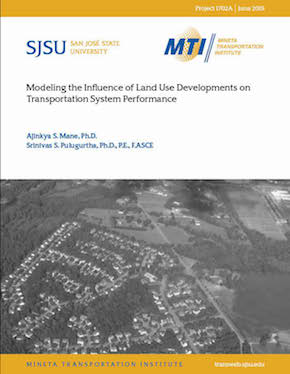- 408-924-7560
- mineta-institute@sjsu.edu
- Donate
Modeling the Influence of Land Use Developments on Transportation System Performance
The growth in the urban population has influenced urban sprawl, congestion, and subsequently, delays on the existing road infrastructure. New land use developments occur in every part of the city due to rapid economic development and to meet the demand for better living standards. The induced traffic volume generated from such land use developments often results in increased congestion and vehicular delay on the existing roads. With recent advancements in the technology, it is possible to capture continuous, and comprehensive travel time data for every major corridor in a city. Therefore, the goal of this research is to model the influence of land use developments on travel time variations to improve the mobility of people and goods.
Data for 259 road links were selected within the city of Charlotte, North Carolina (NC). Three years of travel time data, from the year 2013 to the year 2015, were collected from the private agency. Thirty-five different types of land use developments were considered in this research. The spatial dependency was incorporated by considering the land use developments within 0.5 miles, 1 mile, 2 miles, and 3 miles of the selected road link. Forty-eight statistical models were developed.
The results obtained indicate that land use developments have a significant influence on travel times. Different land use categories contribute to the average travel time based on the buffer width, area type, and the link speed limit. Developing the models by classifying the links based on the speed limit (< 45 mph, 45 to 50 mph, and > 50 mph) was observed to be the best approach to examine the relationship between land use developments and the average travel time. Also, typically travel time on a selected road link is higher during the evening peak period compared to the morning peak and the afternoon off-peak period. Further, the results obtained indicate that the number of lanes and the posted speed limit are negatively associated with the travel time of the selected link.
AJINKYA S. MANE, PhD
Dr. Ajinkya S. Mane has completed his PhD in Infrastructure and Environmental Systems at the University of North Carolina at Charlotte. He earned his master’s degree in Transportation Engineering and a bachelor’s degree in Civil Engineering from India. Before joining the PhD program, he worked as a Project Associate at the National Institute of Technology, Surat, India (NIT-Surat) on the development of guidelines for Indian Highway Capacity Manual. His areas of interest are transportation planning, traffic safety, and traffic operations.
SRINIVAS S. PULUGURTHA, PhD, PE, F.ASCE
Dr. Srinivas S. Pulugurtha, PE, F.ASCE is currently working as Professor & Research Director of the Department of Civil & Environmental Engineering at The University of North Carolina at Charlotte (UNC Charlotte). He teaches graduate as well as undergraduate courses and conducts research in the transportation engineering field. He is also currently directing the Infrastructure, Design, Environment, and Sustainability (IDEAS) Center on UNC Charlotte campus. Prior to his appointments at UNC Charlotte, Dr. Pulugurtha worked as Assistant Director and Assistant Research Professor of the University of Nevada, Las Vegas - Transportation Research Center (UNLV-TRC), from September 1998 to August of 2005. Dr. Pulugurtha has experience working in diverse fields of transportation. They include traffic safety, Intelligent Transportation Systems (ITS), transportation system planning, Geographic Information Systems (GIS) applications, data analytics and visualization, Internet applications, traffic operations, and, artificial intelligence (AI) techniques and operations research applications. During his 25-year tenure as a researcher, Dr. Pulugurtha has led and completed over 70 sponsored projects as Principal Investigator or co-Principal Investigator. He authored / co-authored over 250 publications (includes 70 journal papers). He also made over 150 technical presentations at international, national, regional and local conferences.
-
Contact Us
San José State University One Washington Square, San Jose, CA 95192 Phone: 408-924-7560 Email: mineta-institute@sjsu.edu






